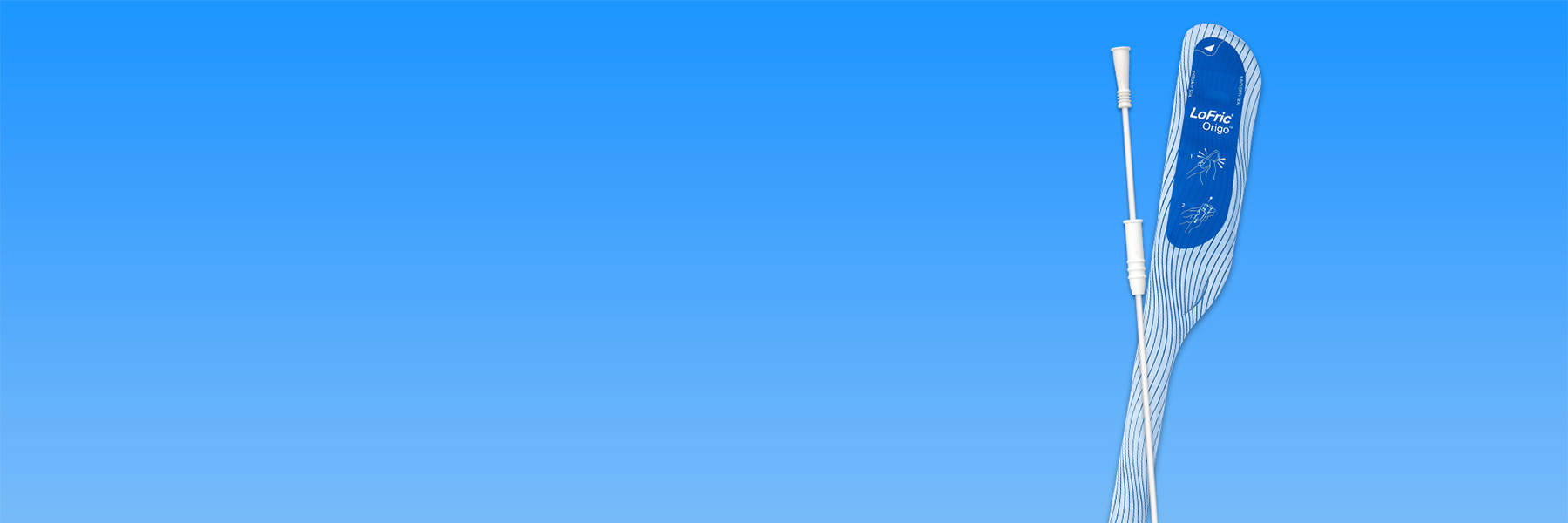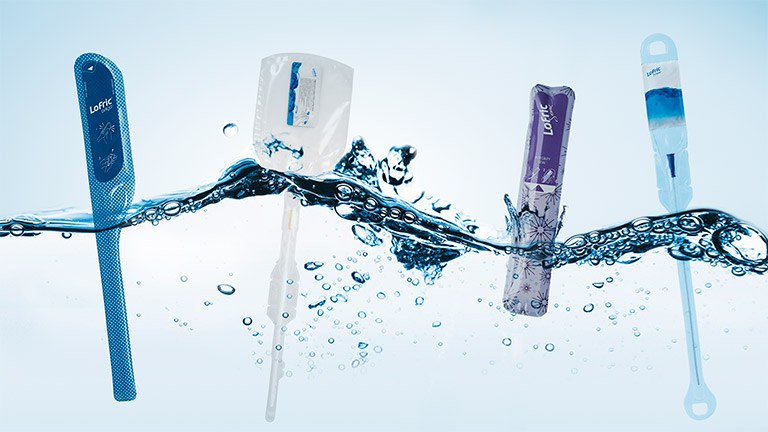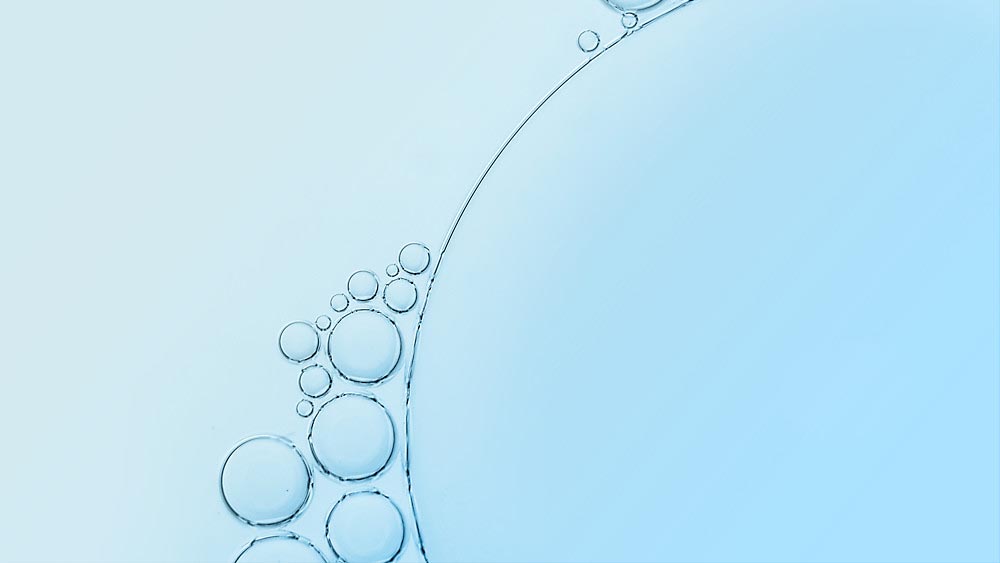The choice you can always trust.
User-friendly hydrophilic catheters adapted to your body for long-term comfort and safety.
LoFric is a complete solution for short- and long-term bladder management. The LoFric product family consists of a wide range of different hydrophilic, intermittent catheters developed and designed to fit into everyday life. They all have smart features to make intermittent catheterisation as easy, comfortable and safe as possible, in any situation. Based on the unique Urotonic™ Surface Technology, LoFric enables intermittent catheterisation in a safe and user-friendly way.
LoFric® catheters have been on the market for more than 30 years. Over the years, we have also innovated new catheters that are more discreet and even easier to use to make life simpler for users. Behind LoFric, you will find a dedicated team who believe in what we do. We are well known by customers and healthcare professionals for our expertise and commitment to urological products, our services and support. We work for a world where urinary issues should not affect people´s potential to live a full and free life.
LoFric reduces the risk of discomfort
The unique Urotonic Surface Technology™ (UST) regulates the catheter surface’s osmolality to match urine osmolality. This facilitates gentle catheterisation by making the catheter smooth at insertion and withdrawal minimising the risks of urethral trauma, bleeding and strictures.
...and it is scientifically proven
LoFric are the only catheters proven in multiple studies to be safe for long-term use.
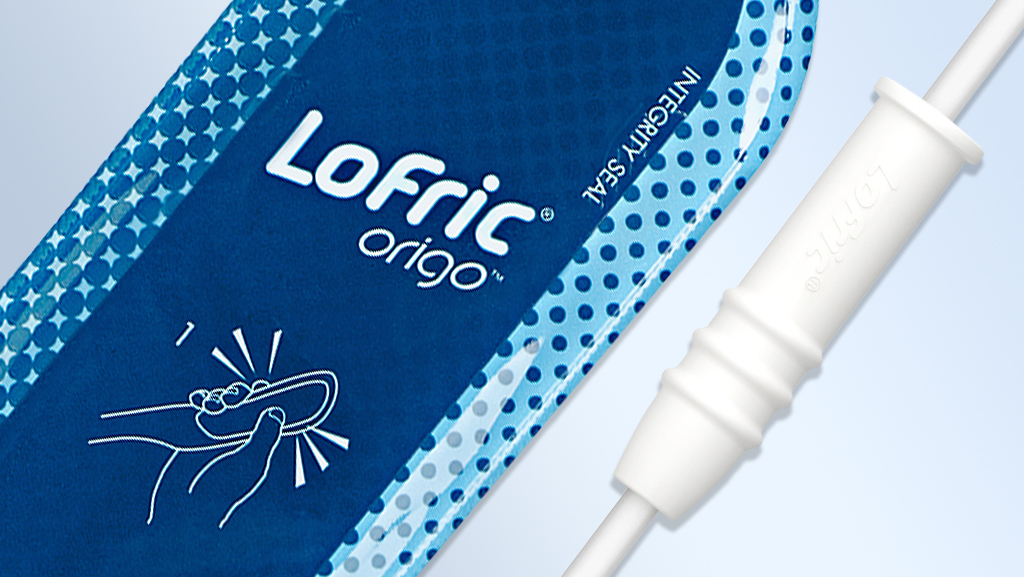 |
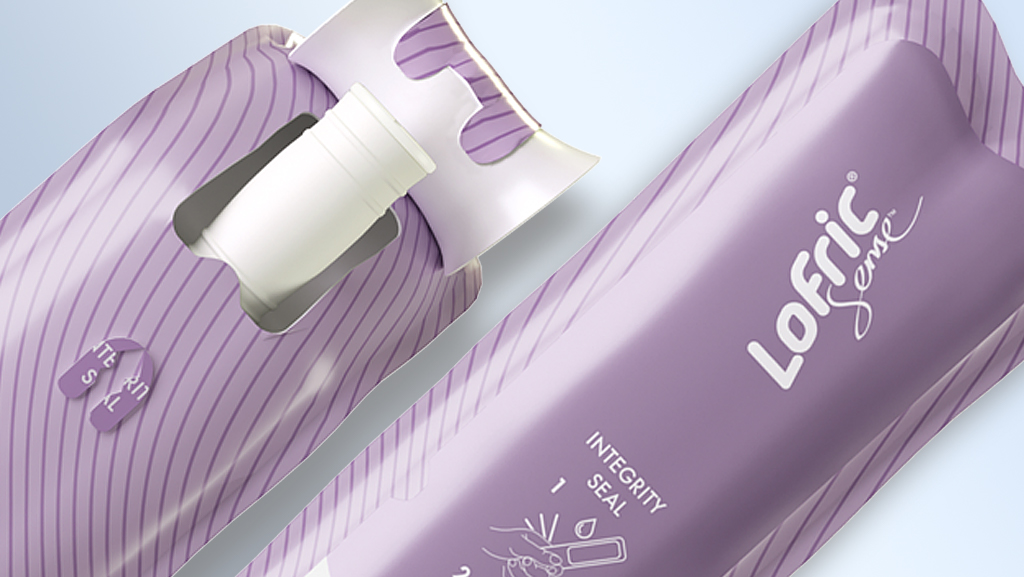 |
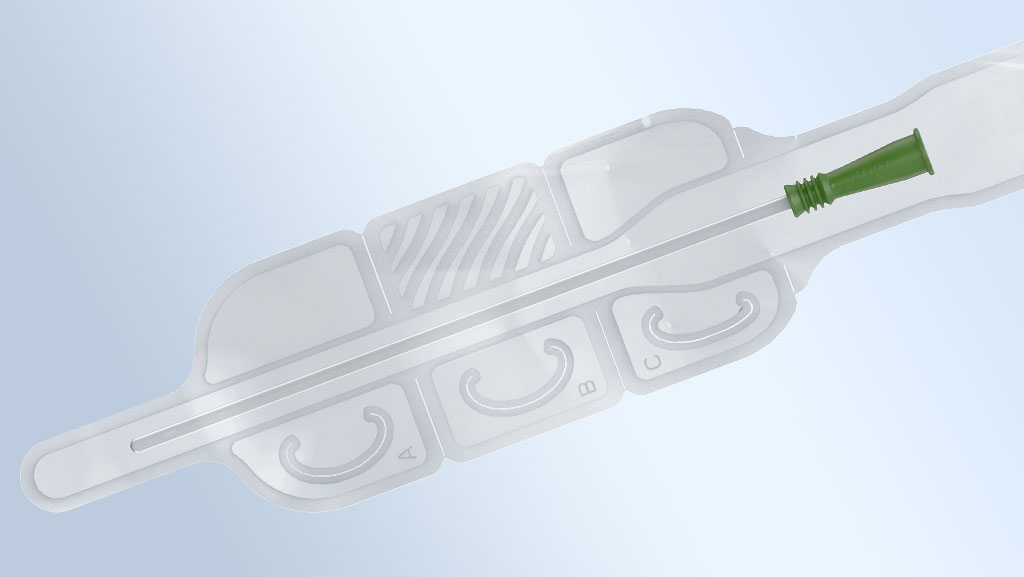 |
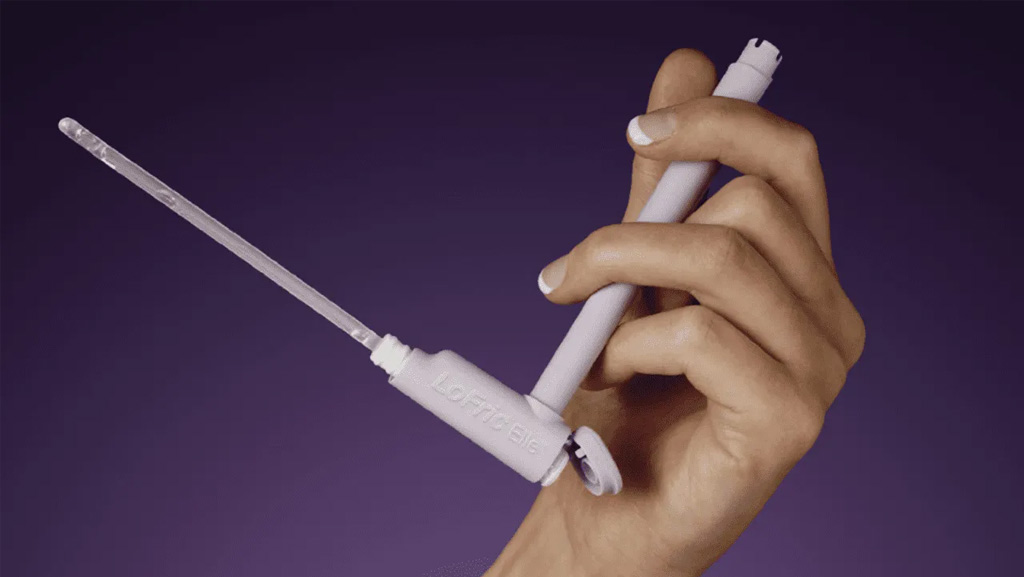 |
| LoFric Origo | LoFric Sense | LoFric Hydro-Kit | LoFric Elle |
| LoFric Origo our latest catheter for men. Safe catheterisation in a clever package. | The catheter tailor-made for women’s needs. Small and discreet yet still long enough for complete bladder emptying. | An all-in-one catheter system – it includes the catheter with water and an integrated urine collection bag. | Ready-to-use, in-out catheter with an L-shaped handle. |
Different products for different needs and situations
LoFric Origo, our newest catheter for men – Safe catheterisation in a clever package
LoFric Origo is the instantly-activated male catheter that makes life easier for experienced users and beginners alike. Discreetly packaged and foldable, LoFric Origo is easy to carry and use anywhere you happen to be. Its unique Insertion Grip provides extra control with no need to touch the catheter tube, ensuring safe and hygienic catheterisation.
LoFric Sense is an attractive choice for women
Extra small and discreet - yet still long enough for complete bladder emptying. LoFric Sense includes everything needed for safe and comfortable catheterisation anywhere. LoFric Sense is tailor-made for women.
LoFric is an all-purpose catheter
LoFric is our original low-friction catheter. It is ideal for both busy hospitals and for patient use at home. LoFric requires clean water for activation of the Urotonic™ Surface Technology low-friction coating on the tubing. Available in sizes for men, women and children.
LoFric Hydro-Kit is truly an all-in-one catheter system
LoFric Hydro-Kit is an all-in-one catheter system. It includes the catheter, a water sachet and an integrated urine collection bag. Wheelchair users find it particularly convenient, and its collection bag also makes it ideal for bedridden patients in need of post-op bladder emptying. LoFric Hydro-Kit offers the freedom and reassurance to catheterise safely wherever the user is, whenever needed, whether toilet facilities are available or not. Available in sizes for men, women and children.
LoFric Dila-Cath is specially designed for treatment of recurrent urethral strictures
It is easy and hygienic to handle and is coated with the low-friction coating to minimise discomfort and the risk of complications. Only available in 40 cm length.
LoFric Insti-Cath is used to administer pharmaceuticals directly into the bladder
It has the same friction minimising UST coating as any other LoFric catheter. It is equipped with a special connector, the Luer-lock, that prevents spills or leaks. Available in sizes for men, women and children.
Do you meet patients who experience discomfort during catheter removal?
Every catheterisation causes strain on the urethra. The problem is not only acute one-off damages to the urethra, but the fact that over time these microtraumas might add up and become a real complication, such as a urinary tract infection and/or a stricture. Most complications occur after 5 years of CIC1.
1. Wyndaele and Maes. J Urol 1990;143:906-908
Catheter with low osmolalityThis catheter has a coating with an osmolality lower than urine. What will happen? In nature’s strive for balance, the water molecules will leave the catheter surface and move towards the urethra. This may cause the catheter to dry out and friction to increase upon removal. |
 |
Catheter with high osmolalityThis is a catheter with a high osmolality. The surface is isotonic to urine, which means it has the same concentration of salt as the body/urethra itself. The water molecules will remain in place, ensuring that the catheter’s low friction is maintained throughout the whole catheterisation procedure. |
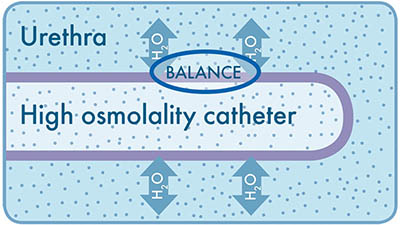 |
LoFric is just as slippery coming out as going in!
LoFric® is proven to reduce the risk of long-term complications1.
The secret is the unique UrotonicTM Surface Technology built on high osmolality which keeps the catheter surface slippery – even if the catheterization takes a long time2.
Maintaining the low friction surface during the whole catheterization is a key principle for avoiding microtrauma and discomfort upon removal.
It may sound complicated, but watch the movie above to straighten the questionmarks.
1. Waller et al. J Urol 1995;153:345-348
2. Lundgren et al. Spinal Cord 2000;38:45-50
Urotonic Surface TechnologyLoFric is the only catheter in the world with Urotonic™ Surface Technology. This method has been developed to make bladder emptying easier and more gentle. The secret behind Urotonic Surface Technology is a chemical process that makes the surface ’isotonic’ to urine. This means that the salt content on the catheter's surface is the same as in your urine. This salt content makes the water on the moist surface stay there during the entire catheterisation procedure. It’s why LoFric catheters are just as slippery coming out as they are going in. |
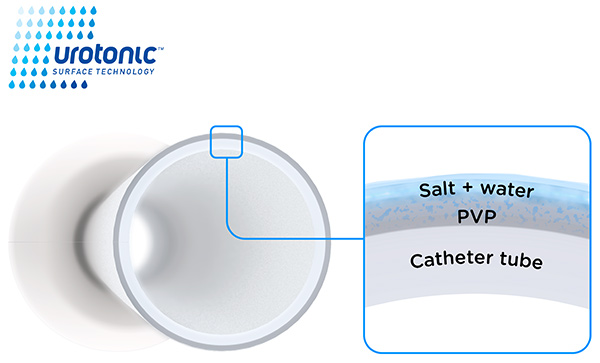 |
LoFric studies
LoFric catheters are by far the most well-documented and tested catheters available.
Find the documentation divided into subjects here:
Long Term Safety
Evidence on the long term use of hydrophilic catheters to reduce UTI and prevent urethral trauma.
Bakke A, Digranes A, Hoisaeter PA (1997)
Physical predictors of infection in patients treated with clean intermittent catheterisation: 7-year study
Long term evidence that intermittent catheterisation using LoFric reduces the risk for urethral complications, including UTI. For example, 65% UTI-free and 39% with sterile urine after long term LoFric use.
7 year follow up on 155 LoFric patients.
Waller L, Jonsson O, Norlen L, Sullivan L (1995)
Clean intermittent catheterisation in spinal cord injury patients: long-term followup of a hydrophilic low friction technique
Evidence on the long term use of hydrophilic catheters to reduce UTI and prevent urethral trauma. For example, no new urethral trauma was identified during a 5-9 year follow up with LoFric.
5-9 year follow up on 30 LoFric patients.
UTI
Evidence on the low frequency of UTI with hydrophilic catheters (LoFric).
Li L, Ye W, Ruan H, Yang B, Zhang S (2013)
Impact of hydrophilic catheters on urinary tract infections in people with spinal cord injury: systematic review and meta-analysis of randomised controlled trials
Evidence of a 64% risk reduction for UTI with hydrophilic coating compared to non-hydrophilic catheters.
Meta-analysis of 464 patients and five randomised controlled trials (RCT) with hydrophilic catheters, whereof three with LoFric.
Cardenas DD, Hoffman JM (2009)
Hydrophilic catheters versus noncoated catheters for reducing the incidence of urinary tract infections: a randomised controlled trial
Evidence of fewer antibiotic treated UTIs in patients using LoFric compared to plastic catheters.
1 year follow-up on 22 LoFric users and 23 PVC -users.
Vapnek JM, Maynard FM, Kim J (2003)
A prospective randomised trial of the LoFric hydrophilic coated catheter versus conventional plastic catheter for clean intermittent catheterisation
Example of a significant decrease in the incidence of UTI with the use of LoFric compared to uncoated plastic catheters with added lubricant.
1 year study on 22 LoFric users and 26 PVC –users.
Bakke A, Digranes A, Hoisaeter PA (1997)
Physical predictors of infection in patients treated with clean intermittent catheterisation: 7-year study
Long term evidence that CIC using LoFric reduces the risk for urethral complications, including UTI. For example, 65% UTI-free and 39% with sterile urine after long term LoFric use.
7 year follow up on 155 LoFric patients.
Waller L, Jonsson O, Norlen L, Sullivan L (1995)
Clean intermittent catheterisation in spinal cord injury patients: long-term followup of a hydrophilic low friction technique
Evidence on the long term use of hydrophilic catheters to reduce UTI and prevent urethral trauma.
5-9 year follow up on 30 LoFric patients.
Bakke A, Vollset SE (1993)
Risk factors for bacteriuria and clinical urinary tract infection in patients treated with clean intermittent catheterisation
Study discussing the risk factors of acquiring UTI.
13 month study on 302 user (95% LoFric).
Bakke A, Vollset SE, Hoisaeter PA, Irgens LM (1993)
Physical complications in patients treated with clean intermittent catheterisation
Evidence on fewer and less severe infections associated with LoFric use compared to uncoated plastic catheters with added lubricant. For example, patients using uncoated catheters had a 76% higher infection score.
13 month Study on 302 users (95% LoFric).
Bakke A, Digranes A (1991)
Bacteriuria in patients treated with clean intermittent catheterisation
Evidence on the low frequency of UTI with hydrophilic catheters (LoFric). For example, 86% of patients showed no clinical signs of UTI during the study period.
13 month Study on 302 users (95% LoFric).
Trauma
Evidence of risk-reduction for hematuria and urethral irritation with LoFric.
Li L, Ye W, Ruan H, Yang B, Zhang S (2013)
Impact of hydrophilic catheters on urinary tract infections in people with spinal cord injury: systematic review and meta-analysis of randomised controlled trials
Evidence of a 43% risk-reduction for hematuria with hydrophilic coated catheters compared to non-hydrophilic catheters.
Meta-analysis of 464 patients and five randomised controlled trials (RCT) with hydrophilic catheters, whereof three with LoFric.
Stensballe J, Looms D, Nielsen PN, Tvede M (2005)
Hydrophilic-coated catheters for intermittent catheterisation reduce urethral micro trauma: a prospective, randomised, participant-blinded, crossover study of three different types of catheters
Evidence of less microscopic hematuria and pain with LoFric. For example, frequency of hematuria was 40% in LoFric, 58% in SpeediCath and 67% in Incare Advance (PVC)
Cross-over study on LoFric and other hydrophilic and non-hydrophilic catheters in 40 healthy volunteers.
Vapnek JM, Maynard FM, Kim J (2003)
A prospective randomised trial of the LoFric hydrophilic coated catheter versus conventional plastic catheter for clean intermittent catheterisation
Evidence on lower incidence of hematuria with Lofric compared with uncoated plastic catheters with added lubricant. For example, no hematuria was reported for the LoFric group while mild hematuria was reported for the control group.
1 year study on 22 LoFric users and 26 PVC catheter-users.
Hedlund H, Hjelmas K, Jonsson O, Klarskov P, Talja M (2001)
Hydrophilic versus non-coated catheters for intermittent catheterisation
Evidence on decreased urethral irritation with hydrophilic catheter, primarily related to LoFric studies.
Review on hydrophilic catheters.
Sutherland RS, Kogan BA, Baskin LS, Mevorach RA (1996)
Clean intermittent catheterisation in boys using the LoFric catheter
Evidence of significantly less hematuria with LoFric compared to uncoated plastic catheter with added lubricant. For example, 9 episodes of hematuria were detected in 6 subjects who used LoFric and 19 episodes were detected in 11 subjects in the control group after 2 months use.
2 months study on 16 LoFric users and 14 PVC catheter users.
Vaidyanathan S, Soni BM, Dundas S, Krishnan KR (1994)
Urethral cytology in spinal cord injury patients performing intermittent catheterisation
Evidence of LoFric causing less urethral inflammation and presence of bacteria than PVC and urethral indwelling catheters. The study shows a more than 10-fold increase in urethral inflammatory response with PVC catheters compared with LoFric.
Study on 17 LoFric, 14 PVC and 11 indwelling catheter users.
Hellstrom P, Tammela T, Lukkarinen O, Kontturi M (1991)
Efficacy and safety of clean intermittent catheterisation in adults
Evidence on the low incidence of urethral complications associated with LoFric. No cases of urethral trauma were observed during the study period.
40 month follow-up study on 41 LoFric users.
Friction
Evidence of lower insertion/withdrawal friction of hydrophilic coated catheters (LoFric).
Jones DS, Garvin CP, Gorman SP (2001)
Design of a simulated urethra model for the quantitative assessment of urinary catheter lubricity
Evidence of lower insertion/withdrawal friction of hydrophilic coated catheters.
In vitro study on LoFric and other hydrophilic catheters.
Lundgren J, Bengtsson O, Israelsson A, Jonsson AC, Lindh AS, Utas J (2000)
The importance of osmolality for intermittent catheterisation of the urethra
Evidence of lower friction and less epithelial cell damage with high osmolality associated with the LoFric catheter.
Histology study in rabbit.
Waller L, Telander M, Sullivan L (1997)
The importance of osmolality in hydrophilic urethral catheters: a crossover study
Provides evidence that physiological osmolality of the hydrophilic catheter coating results in less sticking and lower withdrawal friction. For example, 3 incidents of sticking were observed in 2 patients among LoFric users while 42 incidents of sticking were observed in 9 patients among users of other hydrophilic catheter.
Cross-over study on LoFric and other hydrophilic catheter in 14 users.
Patient Preference
Study reports on high satisfaction rates with LoFric.
Wilson M. (2015)
Clean intermittent self-catheterisation: working with patients
LoFric Origo and LoFric Sense are mentioned as catheters that may help patients practicing the technique correctly.
Expert statement describing important aspects of teaching intermittent catheterisation including using LoFric and other hydrophilic catheters.
Woodward S (2013)
Improving quality of life for men using intermittent self-catheterisation
Focus on the advantages of intermittent catheterisation and how LoFric (and other hydrophilic catheters) can promote independence and improve QoL. Expert statement on LoFric and other hydrophilic catheters.
Sallami S, Mouine Y, Rhouma SB, Cherif K, Dahmani A, Horchani A (2011)
Clean Intermittent Catheterisation Following Urethral Stricture Surgery Using a Low Friction Catheter Versus Conventional Plastic Catheter: A Prospective, Randomised Trial
Study shows that Lofric users were more satisfied, had increased comfort and increased QoL compared to patients using plastic catheters.
2 year follow-up on 31 LoFric users and 28 PVC-users.
Taskinen S, Fagerholm R, Ruutu M (2008)
Patient experience with hydrophilic catheters used in clean intermittent catheterisation
An example of LoFric showing good insertion and removal properties (85-90%).
Evaluation of 100 LoFric and other hydrophilic catheter users.
Bjerklund Johansen T, Hultling C, Madersbacher H, Del Popolo G, Amarenco G, LoFric Primo Study G (2007)
A novel product for intermittent catheterisation: its impact on compliance with daily life--international multicentre study
Study reports on high satisfaction rates with LoFric. For example, Lofric was shown to improve patients’ ability to comply with everyday life and 74% of patients previously using plastic catheters wished to continue with LoFric.
2-week study on 378 users.
Litherland AT, Schiotz HA (2007)
Patient-perceived discomfort with two coated urinary catheters
An example of the low level of discomfort with LoFric.
Prospective study on 196 LoFric and other hydrophilic catheter users.
Fader M, Moore KN, Cottenden AM, Pettersson L, Brooks R, Malone-Lee J (2001)
Coated catheters for intermittent catheterisation: smooth or sticky?
Example of minimised discomfort with LoFric and other hydrophilic catheters.
Evaluation of 61 users.
Lopez Pereira P, Martinez Urrutia MJ, Lobato L, Rivas S, Jaureguizar Monereo E (2001)
Comparative study of the degree of patient satisfaction in intermittent catheterisation with Lofric and polyvinyl chloride catheters
Evidence on higher satisfaction among Lofric users compared to patients using uncoated plastic catheter. For example, 83% of those who experienced withdrawal discomfort reported that this disappeared with Lofric and 86% found LoFric easy or very easy to learn and use.
2-month study on 35 LoFric users.
Pascoe G, Clovis S (2001)
Evaluation of two coated catheters in intermittent self-catheterisation
An example of LoFric showing good insertion, -and removal properties. ~ 90% of LoFric users found the catheter comfortable to insert and easy to remove.
Cross-over study on LoFric and SpeediCath in 25 users.
Mauroy B, Soret R, Bonnal JL, Fantoni JC. (2001)
Comparison of 3 self lubrificated urethral catheters: prospective study on 27 patients
An example of LoFric showing high satisfaction for catheter management, insertion/withdrawal properties and performance.
Prospective and randomised study in 27 users who evaluated LoFric and 2 other hydrophilic catheters.
Pachler J, Frimodt-Møller C (1999)
A comparison of prelubricated hydrophilic and non-hydrophilic polyvinyl chloride catheters for urethral catheterisation
An example of a trend toward easier management and preferences associated with LoFric.
Cross-over study with 32 users who tested LoFric and a non-coated plastic catheter for 3 weeks each.
Sutherland RS, Kogan BA, Baskin LS, Mevorach RA (1996)
Clean intermittent catheterisation in boys using the LoFric catheter
Evidence on high satisfaction (81%) among patients when using LoFric compared to uncoated plastic catheters.
2-month study on 16 LoFric and 14 PVC catheter-users.
Diokno AC, Mitchell BA, Nash AJ, Kimbrough JA (1995)
Patient satisfaction and the LoFric catheter for clean intermittent catheterisation
Evidence on high satisfaction among patients using LoFric compared to uncoated plastic catheter. For example, 81% found LoFric more convenient and favorable and 88% thought it was easier to handle.
1-month study on 41 LoFric users.
Montagnino B (2000)
The LoFric catheter: new technology improves an old technique
Review on the overall benefits of using LoFric instead of plastic catheters for IC.
Dilatation
Evidence of the preventative effects of intermittent self-dilatation (ISD) on stricture recurrence.
Rijal A, Little B, McPhee S, Meddings RN (2013)
Bladder outflow problems in females
Example on LoFric use to treat and prevent recurrent urethral strictures.
Study on 188 females with bladder outflow problems.
Sallami S, Mouine Y, Rhouma SB, Cherif K, Dahmani A, Horchani A (2011)
Clean Intermittent Catheterisation Following Urethral Stricture Surgery Using a Low Friction Catheter Versus Conventional Plastic Catheter: A Prospective, Randomised Trial
RCT on the prevention and/or treatment of recurrent strictures after endoscopic urethrotomy using LoFric and plastic catheters. Study was favorable for Lofric.
2 year follow-up on 31 LoFric users and 28 PVC-users.
Lauritzen M, Greis G, Sandberg A, Wedren H, Ojdeby G, Henningsohn L (2009)
Intermittent self-dilatation after internal urethrotomy for primary urethral strictures: a case-control study
Evidence of the preventative effects of intermittent self-dilatation (ISD) on stricture recurrence. For example, stricture recurrence was 8% among those who practiced ISD with hydrophilic catheters and 32% in the control. The median time to first recurrence was 2 years for the ISD group and 6 months for the control.
3-6 year study on 55 LoFric and other hydrophilic catheter- users and 162 control patients.
Harriss DR, Beckingham IJ, Lemberger RJ, Lawrence WT (1994)
Long-term results of intermittent low-friction self-catheterisation in patients with recurrent urethral strictures
Evidence that Lofric is a safe and effective way to prevent stricture recurrence in the long term (>12 months)
6-36 months study on 101 LoFric users.
Kjaergaard B, Walter S, Bartholin J, Andersen JT, Nohr S, Beck H, Jensen BN, Lokdam A, Glavind K (1994)
Prevention of urethral stricture recurrence using clean intermittent self-catheterisation
Provides evidence for the use of LoFric to effectively reduce the frequency of recurrent urethral strictures. For example, 68% of patients not treated with intermittent catheterisation experience recurrent strictures during the first year after urethrotomy compared to 19% in the LoFric group.
1-4 year study on 31 LoFric users and 24 control patients.
Bodker A, Ostri P, Rye-Andersen J, Edvardsen L, Struckmann J (1992)
Treatment of recurrent urethral stricture by internal urethrotomy and intermittent self-catheterisation: a controlled study of a new therapy
No recurrent strictures in patients actively practicing intermittent catheterisation. Study suggests prolonged or permanent use of intermittent catheterisation in order to prevent recurrence of urethral strictures (refers to Lawrence et al, 1991 and Zambon et al, 1990 on the use of LoFric).
12 month follow-up on 23 patients on intermittent catheterisation with LoFric and 28 control patients.
Robertson GS, Everitt N, Lamprecht JR, Brett M, Flynn JT (1991)
Treatment of recurrent urethral strictures using clean intermittent self-catheterisation
Evidence on LoFric use to treat and prevent recurrent urethral strictures.
6-month study on 65 patients with LoFric.
Lawrence WT, MacDonagh RP (1988)
Treatment of urethral stricture disease by internal urethrotomy followed by intermittent 'low-friction' self-catheterisation: preliminary communication
Study shows that postoperative urine flow-rates can be maintained if 'low-friction' catheterisation is adopted. Study on LoFric, Preliminary results of Harriss et al, 1994.
Instillation
Example on use of LoFric catheters for intravesical instillation.
Dell JR, Parsons CL (2004)
Multimodal therapy for interstitial cystitis
Example on use of LoFric catheters for intravesical instillation.
Review of treatment of Interstitial Cystitis.
Saad A, Oakes G, Thompson AC, Hanbury DC, McNicholas TA, Boustead GB, Woodman AC (2002)
Delaying the Administration of Intravesical Chemotherapy Improves its Dwell Time
Example on the use of LoFric catheters for intravesical instillation.
Study on 42 patients installed with LoFric.
Environment
Evidence on the minimized environmental load with LoFric PVC-free POBE catheter material. and unchanged patient-perception and safety with this material.
Johansson K, Greis G, Johansson B, Grundtmann A, Pahlby Y, Torn S, Axelberg H, Carlsson P (2013)
Evaluation of a new PVC-free catheter material for intermittent catheterisation: a prospective, randomised, crossover study
Evidence of unchanged patient-perception and safety for LoFric with PVC and LoFric with the PVC-free POBE material. For example, patients reported low perceived discomfort with both LoFric-POBE and LoFric-PVC catheters.
1 week cross-over study on 104 LoFric users.
Witjes JA, Del Popolo G, Marberger M, Jonsson O, Kaps HP, Chapple CR (2009)
A multicenter, double-blind, randomised, parallel group study comparing Polyvinyl Chloride and Polyvinyl Chloride-Free Catheter Materials
Evidence of unchanged patient-perception and safety for LoFric with PVC and LoFric with the PVC-free POBE material.
1 month study on 169 LoFric users (81 POBE and 88 PVC).
Stripple H, Westman R, Holm D (2008)
Development and environmental improvements of plastics for hydrophilic catheters in medical care: an environmental evaluation
Evidence on the minimised environmental load with LoFric PVC-free POBE catheter material.
Material life cycle assessment.
Other studies
Halleberg Nyman M, Gustafsson M, Langius-Eklof A, Johansson JE, Norlin R, Hagberg L (2013)
Intermittent versus indwelling urinary catheterisation in hip surgery patients: a randomised controlled trial with cost-effectiveness analysis
Evidence of faster return of normal bladder function after surgery when practicing intermittent catheterisation with LoFric compared to using indwelling catheters
Study on 170 hip surgery patients.
Pettersson-Hammerstad K, Jonsson O, Svennung IB, Karlsson AK (2008)
Impaired renal function in newly spinal cord injured patients improves in the chronic state--effect of clean intermittent catheterisation?
Study shows that improvement of renal function after SCI is most evident in patients practicing intermittent catheterisation.
3-5 year follow-up of 169 patient using LoFric intermittent catheters or indwelling catheters.
Mistry S, Goldfarb D, Roth DR (2007)
Use of hydrophilic-coated urethral catheters in management of acute urinary retention
An example of LoFric use to treat acute urinary retention.
Vaidyanathan S, Krishnan KR, Soni BM, Fraser MH (1996)
Unusual complications of intermittent self-catheterisation in spinal cord injury patients
Case report on 3 rare events solved by LoFric use.
Bakke A, Brun OH, Hoisaeter PA (1992)
Clinical background of patients treated with clean intermittent catheterisation in Norway
Gives statistical information on the use of intermittent catheterisation for persons with different disabilities.
13 month study on 302 users (95% LoFric).
LoFric® is the registered trademark of Wellspect HealthCare.
Product availability and/or product specification may differ between markets, please contact your local representative for more information.








